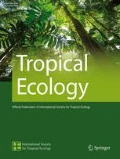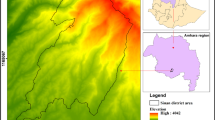Abstract
Forests in developing countries are under tremendous pressure because of increasing dependence of human communities on timber, fodder, non-timber forest products, and fuelwood. Nepal’s forests approximately cover 40% of its total geographical area, which experiences very high human dependence. In the present study, we propose an innovative approach of coupling socio-ecological attributes in Kayarkhola watershed in Churia hills of Nepal using remote sensing datasets and field observations to understand the patterns of fuelwood dynamics. Using multi-temporal moderate resolution satellite datasets, we have analyzed the patterns of land use and land cover change from 1990 to 2010 and assessed the effectiveness of community forestry management. The socio-ecological coupling provided quantification of most significant drivers of fuelwood dynamics. We observed low forest loss in community forests in comparison with those falling outside community forests. We conclude that family size, income levels, and percentage of illiterate persons are the most significant individual factors, whereas these factors along with the availability of agricultural land, supply of alternative energy sources are significantly inversely related drivers controlling the fuelwood dynamics. The scenarios developed in this study can be extrapolated in different landscapes to quantify the fuelwood dynamics, which will help in better forest cover management and conservation.




Similar content being viewed by others
References
Achard F, Eva HD, Stibig HJ, Mayaux P, Gallego J, Richards T, Malingreau JP (2002) Determination of deforestation rates of the world's humid tropical forests. Science 297:999–1002
Acharya KP (2003) Sustainability of support for community forestry in Nepal. For Trees Livelihoods 13:247–260
Bajracharya D (1057e) Fuel, food or forest? Dilemmas in a Nepali village. World Dev 11:1057e74
Baland JM, Bardhan P, Das S, Mookherjee D, Sarkar R (2007) The environmental impact of poverty: evidence from firewood collection in rural Nepal. Revised version of paper presented at the Tenth Conference of the International Association for the Study of Common Property, Oaxaca, Mexico, August 9–13, 2004
Berry PAM, Garlick JD, Smith RG (2007) Near-global validation of the SRTM DEM using satellite radar altimetry. Remote Sens Environ 106(1):17–27
Brosius JP (1997) Endangered forest, endangered people: environmentalist representations of indigenous knowledge. Hum Ecol 25:47–69
Carter AS, Gilmour DA (1989) Increase in tree cover on private farm land in central Nepal. Mt Res Dev 9:381e91
Christensen M, Rayamajhi S, Meilby H (2009) Balancing fuelwood and biodiversity concerns in rural Nepal. Ecol Model 220:522–532
Engoke JV, Dangi RB, Subedi S (2013) Is demand and supply of wood a factor for redd+ project in Nepal? Policy Brief, Ministry of Forests and Soil Conservation REDD-Forestry and Climate Change Cell, Nepal
Foley JA, Asner GP, Costa MH, Coe MT, DeFries R, Gibbs HK, Howard EA, Olson S, Patz J, Ramankutty N, Snyder P (2007) Amazonia revealed: forest degradation and loss of ecosystem goods and services in the Amazon Basin. Front Ecol Environ 5(1):25–32
Fox J (1984) Firewood consumption in a Nepali village. Environ Manage 8:243e9
Gauli K, Rishi P (2004) Do the marginalised class really participate in Community Forestry? A case study from Western Terai Region of Nepal. For Trees Livelihoods 14(2–4):137–147
Heltberg R, Arndt TC, Sekhar NU (2000) Fuelwood consumption and forest degradation: a household model for domestic energy substitution in rural India. Land Econ 76:213e32
Levenson B (1979) Fuelwood utilization: a study of the demand and availability of fuelwood resources at six selected villages. Mimeo, Integrated Watershed Management Project (IWM/PTR/9). Kathmandu: Ministry of Forest, Department of Soil and Water Conservation, His Majesty’s Government
Liu J, Dietz T, Carpenter SR, Alberti M, Folke C, Moran E, Taylor WW (2007) Complexity of coupled human and natural systems. Science 317:1513–1516
Mahat TBS, Griffin DM, Shepherd KR (1987) Human impact on some forests of the middle hills of Nepal. A detailed study in southeast Sindhu Palchok and northeast Kabhre Palanchok. Mt Res Dev 7:111e34
Mbaabu PR, Hussin YA, Weir M, Gilani H (2014) Quantification of carbon stock to understand two different forest management regimes in Kayar Khola watershed, Chitwan. Nepal J Indian Soc Remote 42:745–754
Persha L, Agrawal A, Chhatre A (2011) Social and ecological synergy: local rulemaking, forest livelihoods, and biodiversity conservation. Science 331:1606–1608
Pokharel B, Dech JP (2012) Mixed-effects basal area increment models for tree species in the boreal forest of Ontario, Canada using an ecological land classification approach to incorporate site effects. Forestry 85(2):255–270
Qunicey DJ, Luckman A, Hessel R, Davies R, Sankhayan PL, Balla MK (2007) Fine-resolution remote-sensing and modelling of Himalayan catchment sustainability. Remote Sens Environ 107:430e9
Schmitt CB, Burgess ND, Coad L, Belokurov A, Besançon C, Boisrobert L, Winkel G (2009) Global analysis of the protection status of the world’s forests. Biol Conserv 142:2122–2130
Uddin K, Shrestha HL, Murthy MSR, Bajracharya B, Shrestha B, Gilani H, Pradhan S, Dangol B (2015) Development of 2010 national land cover database for the Nepal. J Environ Manage 148:82–90
Webb EL, Dhakal A (2011) Patterns and drivers of fuelwood collection and tree planting in a Middle Hill watershed of Nepal. Biomass Bioener 35(1):121–132
Acknowledgements
The present study was funded by the “Department for International Development’s (DFID) grant for innovation funds”. The authors are thankful to DFID for providing the grant to conduct the study. The authors express their gratitude to the anonymous reviewers for their valuable comments on the earlier version of the manuscript.
Disclaimer: The views and interpretations in this publication are those of the authors and are not necessarily attributable to ICIMOD.
Author information
Authors and Affiliations
Corresponding author
Rights and permissions
About this article
Cite this article
Chitale, V.S., Murthy, M.S.R., Gilani, H. et al. Understanding socio-ecological drivers of fuelwood dynamics and their impact in Churia hills of Nepal. Trop Ecol 61, 76–83 (2020). https://doi.org/10.1007/s42965-020-00069-7
Received:
Revised:
Accepted:
Published:
Issue Date:
DOI: https://doi.org/10.1007/s42965-020-00069-7




